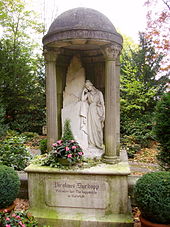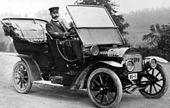Nikolaus Dürkopp

Nicolaus Dürkopp (born February 26, 1842 in Herford , † June 25, 1918 in Bad Salzuflen , full name: Nicolaus Ferdinand Robert Dürkopp , in some official documents also: Dürrkopf , posthumous spelling usually: Nikolaus ) was a German mechanic and entrepreneur . He was one of the two founders of the Bielefeld- based companies Dürkopp Adler AG and Dürkopp Fördertechnik GmbH and contributed significantly to the fact that the city of Bielefeld developed into a center for sewing machine construction and fine industry by 1880 .
life and work
Nicolaus Dürkopp was the son of the ironmonger Karl Heinrich Dürrkopf and his wife Luise Karoline Dürrkopf nee. Hildebrandt. He grew up with his grandmother and attended elementary school in Herford from 1848 to 1856 . He learned to read and write there, but only rudimentary, so that he remained largely illiterate . In 1856 he completed an apprenticeship as a locksmith in Detmold . After several years of wandering in Berlin, Hamburg and Bremen, he became an employee of the precision mechanic and master watchmaker Böckelmann in Bielefeld, where he worked with Heinrich Koch and Carl Baer, who founded the Koch & Co. sewing machine factory in Bielefeld in 1861 . During his time at Böckelmann, he designed his own sewing machine in 1861. In 1865 he switched to Koch & Co. as a mechanic . During the German War of 1866 and the Franco-German War of 1870/1871 , Dürkopp served in the army. Between the wars, on October 22nd, 1867, together with Carl Schmidt, who worked as a master craftsman at Koch & Co. and worked with him, he founded his own sewing machine repair workshop under the company Dürkopp & Schmidt , which now becomes Dürkopp Adler AG and Dürkopp Fördertechnik GmbH developed.
Hardly any other entrepreneur from Bielefeld registered as many patents during the German Empire as Nikolaus Dürkopp. Due to his illiteracy , Dürkopp did not correspond with other entrepreneurs or people in social life, so there are no texts he wrote himself. He had contracts and documents read to him several times before he signed them. He largely stayed away from social life in Bielefeld. In 1877 he married Ida Vogelsang from Hanover . With her he had a son Paul and a daughter Bertha. Although he had previously participated in car races, he did not get a driver's license until August 16, 1910 . After his divorce in 1912, Dürkopp married Emilie geb. Jacket from Bielefeld. Both lived in Bad Salzuflen and adopted a daughter in 1915. Nikolaus Dürkopp died in Bad Salzuflen in 1918 and was buried in the Obernbergfriedhof there.
His son Paul took over the company management. The city of Bielefeld honored Dürkopp by naming a Nikolaus-Dürkopp-Strasse in the Mitte district . Many old factory buildings are now being used for other purposes, but still bear the Dürkopp logo.
Passion for automobiles
In 1894, Nikolaus Dürkopp failed his first attempt to integrate an automotive department into the company. He paid 2 million marks from his private fortune until 1897 when he managed to finance construction attempts. In the further course of automobile production, Nikolaus Dürkopp built a racing car in 1900, with which he achieved his first racing successes on the Aachen – Berlin long-distance journey. Dürkopp's automobiles were always unique pieces that were made to order, which was entirely in keeping with Dürkopp's spirit. Dürkopp set the maxims that the quality and the fulfillment of special customer requests were the top priority. Mass production seemed suspicious to him and he prevented this from happening in his automobiles. Dürkopp was able to finance his peculiarities in automobile production by manufacturing sewing machines and bicycles. Until his death, he mastered all the crises that this part of the company brought with it thanks to his private enthusiasm. Automobile production was only stopped several years after his death. He sacrificed his large riding stable for the development of automobiles, drove test cars himself in order to contribute to new developments, and participated in the planning and technical implementation.
Villa Dürkopp
Today Nikolaus Dürkopp's retirement home, Villa Dürkopp in Bad Salzuflen, is used as a three-star hotel in the middle of a park not far from the spa gardens. The villa comprises a main house and three outbuildings, all of which are listed .
literature
- Andreas Beaugrand, Regine Krull: Nikolaus Dürkopp (1842–1918). In: Wolfhard Weber (Ed.): Bielefeld entrepreneurs from the 18th to the 20th century. (= Rheinisch-Westfälische Wirtschaftsbiographien , Volume 14.) Aschendorff, Münster 1991, pp. 307-320.
- Robert Cohen: Cars from Bielefeld. The development of the Dürkopp company 1897–1930. (= 86th annual report of the historical association for the county of Ravensberg ) Bielefeld 2000.
- Gustav Goldbeck: Dürkopp, Nikolaus. In: New German Biography (NDB). Volume 4, Duncker & Humblot, Berlin 1959, ISBN 3-428-00185-0 , p. 172 ( digitized version ).
- Harald Wixforth: Nikolaus Dürkopp. An innovative entrepreneur from Bielefeld. In: Bielefeld companies in the 19th and 20th centuries. (= Ravensberger Blätter, organ of the historical association for the Grafschaft Ravensberg eV, year 2004, issue 2.)
Web links
- Nicolaus Dürkopp - once completely privately on www.hochrad.info
- October 22nd, 1867 Nikolaus Dürkopp and Carl Schmidt found the sewing machine company "Dürkopp & Schmidt" in Bielefeld on www.bielefeld.de
| personal data | |
|---|---|
| SURNAME | Dürkopp, Nikolaus |
| ALTERNATIVE NAMES | Dürrkopf, Ferdinand Robert Nicolaus (full name) |
| BRIEF DESCRIPTION | German mechanic and entrepreneur |
| DATE OF BIRTH | February 26, 1842 |
| PLACE OF BIRTH | Herford |
| DATE OF DEATH | June 25, 1918 |
| Place of death | Bad Salzuflen |


